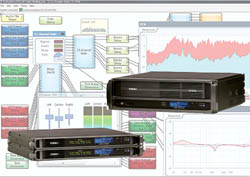
New Q-Sys from QSC Audio is a complete, integrated sound system platform that encompasses everything from the audio input to loudspeakers, providing all audio routing, processing, control and monitoring necessary for any sound reinforcement system while maintaining exceptional audio quality and reliability.
It will be unveiled at the upcoming 2009 InfoComm show at Orlando, with QSC providing demonstrations on the hour beginning at 10 am each day of the show at the company booth, number 6443. And, click here to take a virtual online tour of Q-Sys.
Q-Sys is designed for a wide range of large-scale applications—stadiums and arenas, attractions and theme parks, performing arts venues, transportation hubs, legislative and judicial chambers, hotels and casinos, houses of worship, corporate campuses, educational facilities or anywhere else the need exists for a powerful system-wide audio solution.
The primary elements of a Q-Sys system are the Core and I/O Frame.
The Core performs all audio routing and processing, and also handles all control functions. It is available in three sizes, Core 1000, 3000, and 4000, and features a centralized processing architecture, yet Q-Sys retains the ability to physically locate the input and output connections near their sources and destinations using I/O Frames.
Each I/O Frame can house up to 4 I/O cards enabling up to 16 channels of input and/or output in a single unit.
Available cards include a 4-input standard and a 4-input premium-quality mic/line input card, 4-channel line output card, an AES card with 4-channels of input and output, and a 4-channel card for connection to QSC DataPort amplifiers. Additional cards will be added in the future.
Q-Sys supports multiple levels of redundancy. Network redundancy may be implemented by simply adding additional network switches and cabling. In the event of a network failure, the Q-Sys components switch over instantly to the back-up network.
Core redundancy allows a second core to be connected to the network. Should the primary core fail, the secondary core takes over, and I/O Frame redundancy gives the designer the option of adding redundant I/O Frames for high-priority areas.
Amplifier redundancy is also possible with the use of the QSC DAB-801 (DataPort Amplifier Backup panel), an accessory that connects to the inputs and outputs of five QSC DataPort amplifiers with one amp serving as a backup for the other four (4 + 1 redundancy, using 2-channel amplifiers). A second DAB-801 may be added for 8 + 1 redundancy.
Q-Sys relies on Q-LAN, a proprietary, standards-based, low-latency Gigabit Ethernet network implementation that is responsible for audio routing between devices and ensures that all signals are transmitted from source to destination in less than 1/3rd of a millisecond.
Q-Sys combines Q-LAN with audiophile quality, 32-bit floating point distribution and high performance A/D and D/A converters for exceptional fidelity and a total system latency of less than 2.5 milliseconds. In addition to low latency distribution, Q-Sys also supports long-haul IP streaming of audio over Wide Area Networks (WAN) as well as auto-discovery and configuration of end nodes.
The Q-Sys design environment is laid out without clutter or complicated, multi-level menus, and designs can be compiled and deployed in seconds.
A suite of trouble shooting and measurement tools is also provided. A test probe provides an RTA display of the signal at any point in the design. FFT-based real-time analysis and impulse response are also provided for on-site acoustical measurements.
In the Q-Sys Cores, the internal processing is 64-bit, with even the smallest Core, the Core 1000, offering more DSP resource than is likely to be fully utilized in any real-world application.
In addition to huge processing capacity, Q-Sys offers an extensive selection of processing and control functions, including crossover, delay, dynamics, meters, filters and equalizers, mixers and routers, test and measurement, and a host of other functions such as amplifier load monitoring.
Q-Sys can be used with any amplifiers or loudspeakers, but the system’s power increases exponentially when integrated with QSC loudspeakers and DataPort amplifiers.
For example, using the DataPort output card in conjunction with PowerLight, PL2, PL3, CX, or DCA amplifiers enables complete end-to-end system-level telemetry and supervision, while utilizing QSC loudspeakers opens opportunities for greater control and system reliability by enabling functions such as driver excursion limiting and loudspeaker fault detection.
QSC Audio Website
Click here to take a virtual online tour of Q-Sys.
(Be sure to visit PSW’s 2009 InfoComm New Product Gallery.)
